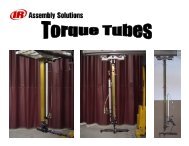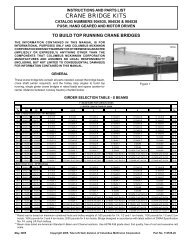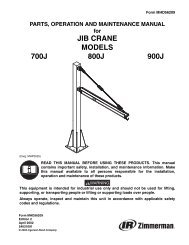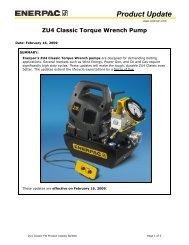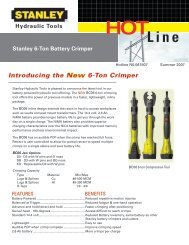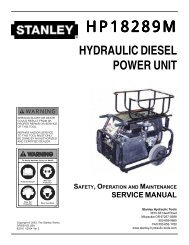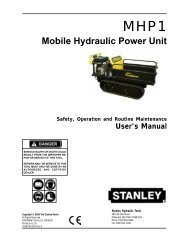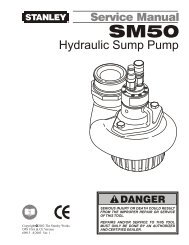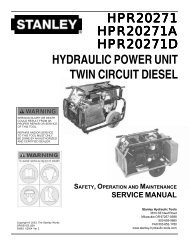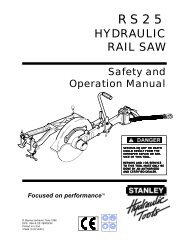Hydraulic Sinker Drill - Tool-Smith
Hydraulic Sinker Drill - Tool-Smith
Hydraulic Sinker Drill - Tool-Smith
You also want an ePaper? Increase the reach of your titles
YUMPU automatically turns print PDFs into web optimized ePapers that Google loves.
2. Apply grease and install an o-ring (21) onto the flow<br />
sleeve tube.<br />
3. Apply clean hydraulic fluid and install 4 push pins<br />
(58) into the holes in the top of the flow sleeve tube.<br />
One end of each push pin contains a machined<br />
surface. This surface must be facing up as each push<br />
pin is installed. Each push pin must slide freely in or<br />
out of the hole. If a push pin does not slide freely or<br />
seems to stick, the hole may contain contamination<br />
or the top edge of the hole contains a burr. Remove<br />
burrs with a deburring tool, clean the hole thoroughly<br />
and try the push pin again.<br />
4. Tap the roll pin (33) into the hole on the automatic<br />
valve body (56).<br />
5. Apply grease and install an o-ring (21) onto the<br />
automatic valve body.<br />
6. Lubricate with clean hydraulic fluid and install 2<br />
push pins (57) into the holes in the valve body. One<br />
end of each push pin contains a machined surface.<br />
This surface must be facing up as each push pin is<br />
installed. Each push pin must slide freely in or out<br />
of the hole. If a push pin does not slide freely or<br />
seems to stick, the hole may contain contamination<br />
or the top edge of the hole contains a burr. Remove<br />
burrs with a deburring tool, clean the hole thoroughly<br />
and try the push pin again.<br />
7. Lubricate the automatic valve (32) with clean<br />
hydraulic fluid and install it into the valve body.<br />
The automatic valve must freely slide back and<br />
forth. If it does not, the valve body or valve may<br />
contain contaminants or the bore of the valve body<br />
contains burrs. Remove the push pins and scrub the<br />
bore of the valve body with emery cloth and then<br />
thoroughly clean the bore, push pin holes and valve.<br />
Reinstall the push pins and valve.<br />
8. Grasp the automatic valve body and valve so that<br />
one or more fingers are gripping the valve to prevent<br />
it and the push pins from falling out when the valve<br />
body and valve are turned upside down (roll pin<br />
facing down). Place the assembly on top of the flow<br />
sleeve making sure the roll pin aligns with the<br />
appropriate hole in the flow sleeve.<br />
9. Lubricate the piston (29) with clean hydraulic fluid<br />
and install into the top of the automatic valve body.<br />
Apply grease and install a new o-ring (28) into the<br />
groove in the piston (water flush models only).<br />
10. Install the washer (27), smaller diameter first, over<br />
the stem of the piston and onto the automatic valve<br />
body.<br />
11. Install the accumulator assembly over the stem of<br />
the piston and down to the top of the automatic<br />
valve body.<br />
12. Insert the air tube (1) (or water tube if applicable)<br />
into the top of the accumulator ensuring it aligns<br />
with the hole in the piston.<br />
13. Use a felt tip marker to place a mark on the accumulator<br />
cylinder and the accumulator housing to align<br />
the tube connector with the port in the accumulator<br />
housing.<br />
14. Apply grease liberally to the o-ring surfaces on the<br />
accumulator, automatic valve body, flow sleeve tube<br />
and to the bore of the accumulator housing.<br />
15. Place the accumulator housing over the top of the<br />
accumulator, ensure that the felt pen marks are<br />
alligned, and then tap it down until the lower part of<br />
the housing covers the o-ring on the flow sleeve<br />
tube.<br />
16. Lay the completed assembly on its side being careful<br />
to prevent movement of the flow sleeve. Remove the<br />
assembly fixture.<br />
17. Place the completed assembly horizontally in a vice<br />
with soft jaws, oil ports up, and clamp on the flow<br />
sleeve tube.<br />
18. Apply grease and Install a new cup seal (93) with<br />
lips facing down, the washer (92), new rod seal (91)<br />
with lips facing up, and a new o-ring (90).<br />
19. Install the motor over the side rods and into the flow<br />
sleeve tube ensuring the roll pin is correctly aligned<br />
with the hole in the flow sleeve and the motor<br />
control valve is oriented correctly with the handles.<br />
20. Install the 4 side rod nuts. Tighten in 20 ft lb/25 Nm<br />
increments to 75 ft lb/100 Nm in a cross pattern.<br />
21. Apply grease and install new o-rings (44 & 45) to<br />
the blower tube nut. Install the blower tube nut to<br />
the accumulator housing.<br />
22. Install the charge valve (14).<br />
23. Charge the accumulator with 600 psi/42 bar nitrogen<br />
as described in the "CHARGING THE ACCUMU-<br />
LATOR" section of this manual.<br />
24. Apply grease and install a new o-ring (13) onto the<br />
charge valve cap (12). Install the charge valve cap.<br />
14



